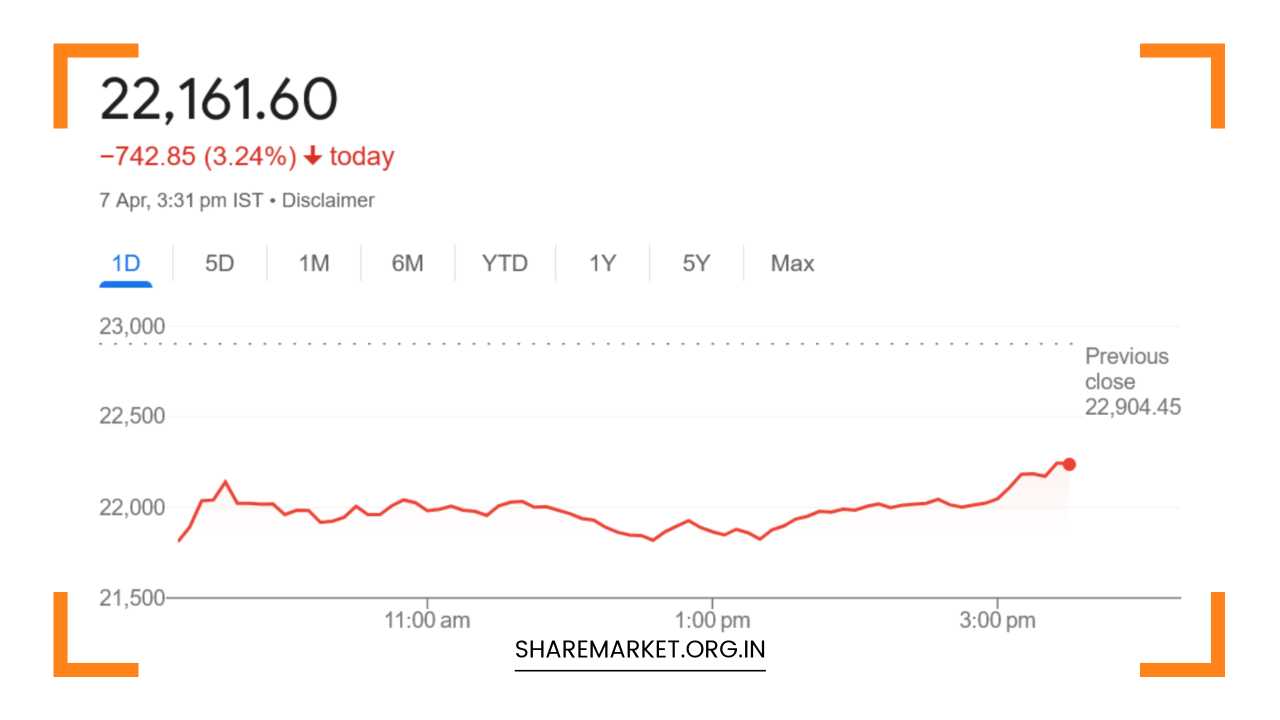Sensex Down 2,226 Points, Nifty at 22,161; Tomorrow Nifty Prediction

Tomorrow Nifty Prediction
Sensex and Nifty Suffer Major Setback: What Lies Ahead for India’s Stock Market?
In a dramatic turn of events, the Sensex and Nifty, the two primary benchmark indices of the Indian stock market, faced their most significant fall in the past 10 months.
On April 7, 2025, both indices plunged sharply, driven by a combination of global economic pressures, heightened fears of a trade war, and concerns about a potential recession.
This marked the beginning of a challenging week for Indian markets, with investors seeing substantial losses across multiple sectors.
Let’s explore the reasons behind this massive sell-off, the outlook for the future, and key strategies for investors in these turbulent times.
The Trigger: Global Tensions and Rising Fears of a Trade War
The global markets have been dealing with a series of macroeconomic challenges, and the Indian stock market was not immune to these global headwinds.
The biggest catalyst for the sharp fall was the renewed escalation in the US-China trade war. The United States, under former President Donald Trump’s administration, imposed a series of tariffs on Chinese goods, which has now been followed by retaliatory measures from China, Canada, and the European Union.
As the trade dispute intensifies, fears of a full-blown global trade war are heightening, making investors nervous about future growth prospects.
This uncertainty surrounding global trade is compounded by concerns that the ongoing tariff wars could push the global economy into a recession.
This has led to a cautious sentiment across global financial markets, including India. The global economic slowdown, exacerbated by these trade tensions, has also negatively impacted investor sentiment in emerging markets, including India.
The sense of instability has led to widespread selling, with many investors opting to exit riskier assets in favor of safer alternatives like gold or government bonds.
A Steep Fall on April 7: Market Overview
On April 7, Indian markets experienced one of their sharpest drops in recent history. The Sensex closed at 73,137.90, down by 2,226.79 points or 2.95%, and the Nifty closed at 22,161.60, losing 742.85 points or 3.24%.
This sell-off wiped out over Rs 12 lakh crore in investor wealth, bringing the market capitalization of BSE-listed companies down from Rs 403 lakh crore to Rs 390 lakh crore.
The sharp declines on these major indices were accompanied by significant losses across various sectoral indices.
The metal sector bore the brunt of the market sell-off, falling 6.7%, reflecting the global slowdown in demand for commodities and the imposition of tariffs.
The realty sector was also hit hard, dropping 5.6%, followed by other sectors such as media, PSU banks, auto, energy, and IT, all of which experienced declines ranging from 2.5% to 4%.
This broad-based decline is indicative of the pervasive sentiment of risk aversion that has gripped the market.
Further exacerbating the losses, the BSE Midcap and Smallcap indices also experienced significant declines, falling by 3.4% and 4% respectively.
These smaller stocks typically carry higher volatility, and their sharper decline signals the depth of the market correction.
On that day, more than 770 stocks on the BSE hit their 52-week lows, including prominent names like Siemens, Jindal Saw, Punjab & Sind Bank, Thermax, Hindustan Copper, DLF, and Bank of Maharashtra.
The Experts Weigh In: What’s Driving the Sell-Off?
Several market experts have weighed in on the reasons behind the dramatic market downturn, with global trade tensions and recession fears being the most prominent factors.
According to Siddharth Khemka, Head of Research and Wealth Management, the primary driver of the market’s downfall is the escalating trade war and the potential for a global economic recession.
The uncertainty surrounding whether the US and its trading partners will be able to reach an agreement before the next phase of tariff hikes is adding to investor anxiety.
Khemka noted that many countries, including China, Canada, and the European Union, have expressed their intentions to retaliate against the US by imposing tariffs on American goods.
As the situation unfolds, it’s creating a sense of uncertainty in the markets, which has intensified the sell-off. Khemka further warned that the fear of a global recession, coupled with the US’s unpredictable foreign policy stance, has spooked investors worldwide.
While these factors weigh heavily on investor sentiment, Khemka advised investors to avoid panic selling.
He emphasized that long-term investors should stick to a disciplined strategy and continue to focus on companies with strong fundamentals and a domestic economic orientation.
Investment Strategy: How to Navigate This Volatile Market
In the face of such significant market declines, it’s crucial for investors to stay calm and avoid making rash decisions.
A well-thought-out investment strategy becomes essential in times like these. Khemka suggested that this market downturn may offer a good opportunity for long-term investors to gradually accumulate shares in fundamentally strong companies.
Particularly, he recommends focusing on sectors that are heavily reliant on India’s domestic economy rather than sectors vulnerable to global risk factors.
Khemka is bullish on consumption, financial, and banking stocks, as these sectors are more insulated from global economic shocks.
In particular, consumption-based sectors, such as FMCG, remain a strong long-term bet for India. While the returns from these sectors may not be spectacular in the short term, they are expected to perform better during periods of global recession.
As consumers continue to spend, even in challenging economic conditions, these companies are likely to show resilience.
Khemka also sees potential in sectors related to crude oil, such as oil distribution companies and aviation, as they may benefit from falling oil prices. A reduction in oil prices could offer some relief to both consumers and businesses in the near term.
Market Technicals and Prediction
From a technical perspective, Aditya Gaggar, director of Progressive Shares, mentioned that the immediate support level for the Nifty is seen at around 21,750, with resistance at 22,300.
The market’s direction in the short term will largely depend on news related to the ongoing trade war and any resolutions or developments regarding tariffs.
If positive news emerges from the global trade front, such as the announcement of a trade deal between the US and its partners, the market could see a sharp recovery.
On the other hand, further negative developments, including additional tariffs or signs of an impending recession, could push the market to even lower levels.
Gaggar stressed that the market’s volatility is likely to persist in the short term, and investors need to remain cautious and keep an eye on global developments.
Final Remarks: A Bumpy Road Ahead for Indian Markets
The current market conditions reflect the ongoing volatility and uncertainty in the global economy. With fears of a global recession and escalating trade tensions driving investor sentiment, Indian markets have faced their most significant decline in months.
While short-term volatility is expected to continue, there are opportunities for long-term investors to capitalize on the current market correction.
The key takeaway for investors is to remain patient and adopt a disciplined approach. Rather than panicking and making hasty decisions, investors should look for opportunities in sectors that are less exposed to global risks and more focused on India’s domestic growth story.
In addition, keeping a close watch on global trade developments will be crucial in determining the future direction of the market. For now, it’s essential to stay calm, stay informed, and focus on the long-term horizon.

















